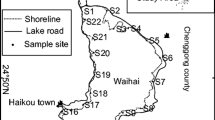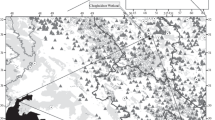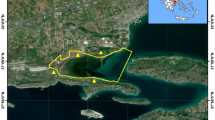Abstract
Loss of natural wetlands is a global phenomenon that has been a serious threat to the wildlife. A common practice is to construct artificial wetlands to compensate for the loss of natural wetlands. To test whether artificial wetlands as habitats for waterbirds are good alternatives to natural wetlands, we compared species richness, abundance, and seasonal dynamics of waterbird communities of natural (here tidelands) and artificial wetlands (here aquacultural ponds) on Chongming Island, China. Our results indicate that habitat preference of waterbirds showed seasonal difference: most of the shorebirds were found on tidelands in spring, whereas most of the natatorial birds were recorded in aquacultural ponds in winter. Waterbirds preferred the tidelands rather than aquacultural ponds in both spring and autumn, whereas they showed no preference for either the tidelands or the ponds in summer and winter. It is concluded that natural wetlands are better habitats for waterbirds than artificial wetlands on Chongming Island, while the artificial ones are also suitable habitats for waterbirds in winter. The waterbirds might use artificial wetlands only when natural wetlands are unavailable or of poor quality. An over-emphasis that artificial wetlands are suitable habitats for waterbirds might encourage land managers to convert natural wetlands into the artificial ones, resulting in considerable loss of bird diversity. Therefore, for the purpose of bird conservation, it would be a better practice to conserve natural wetlands rather than to construct artificial ones after destruction of natural wetlands.
Similar content being viewed by others
References
Acosta M., Mugica L., Mancina C. and Ruiz X. 1996. Resource partitioning between glossy and white ibises in a rice field system in south-central Cuba. Colonial Waterbirds 19: 65–72.
Barter M., Tonkinson D., Tang S.X. and Qian F.W. 1997.Wader number on Chongming Dao, Yangtze Estuary, China, during early 1996: northward migration and the conservation implications. Stilt 30: 7–13.
Boulinier T., Nichols J.D., Sauer J.R., Hines J.E. and Pollock K.H. 1998. Estimating species richness: the importance of heterogeneity in species detectability. Ecology 79: 1018–1028.
Burnham K.P. and Overton W.S. 1978. Estimation of the size of a closed population when capture probabilities vary among animals. Biometrika 65: 625–633.
Burnham K.P. and Overton W.S. 1979. Robust estimation of population size when capture probabilities vary among animals. Ecology 60: 927–936.
Cody M.L. 1985. Habitat Selection in Birds. Academic Press Inc., Orlando, Florida.
Colwell M.A. and Taft O.W. 2000.Waterbird communities in managed wetlands of varying water depth. Waterbirds 23: 45–55.
Day J.H. and Colwell M.A. 1998. Waterbird communities in rice fields subjected to different post-harvest treatments. Colonial waterbirds 21: 185–197.
Duncan P., Hewison A.J.M., Houte S., Rosoux R., Tournebize T., Dubs F. et al. 1999. Long-term changes in agricultural practices and wildfowling in an internationally important wetland, and their effects on the guild of wintering ducks. Journal of Applied Ecology 36: 11–23.
Elphick C.S. 2000. Functional equivalency between rice fields and semi-natural wetland habitats. Conservation Biology 14: 181–191.
Elphick C.S. and Oring L.W. 1998. Winter management of Californian rice fields for waterbirds. Journal of Applied Ecology 35: 95–108.
Erwin R.M., Dawson D.K., Stotts D.B., Mcallister L.S. and Geissler P.H. 1991. Open marsh water management in the mid-Atlantic region-Aerial surveys of waterbird use. Wetlands 11: 209–228.
Froneman A., Mangnall M.J., Little R.M. and Crowe T.M. 2001. Waterbird assemblages and associated habitat characteristics of farm ponds in theWestern Cape, South Africa. Biodiversity and Conservation 10: 251–270.
Guillemain M., Fritz H. and Guillon N. 2000. The use of an artificial wetland by Shoveler Anas clypeata in western France: the role of food resources. Revue D'Ecologie-La Terre Et La Vie 55: 263–274.
Hines J.E., Boulinier T., Nichols J.D., Sauer J.R. and Pollock K.H. 1999. COMDYN: software to study the dynamics of animal communities using a capture-recapture approach. Bird Study 46: 209–217.
Huang Z.Y., Sun Z.H., Yu K., Zhou M.Z., Zhao R.Q. and Gao J. 1993. Bird Resources and Habitats in Shanghai. Fudan University Press, Shanghai, China.
Isola C.R., Colwell M.A., Taft O.W. and Safran R.J. 2000. Interspecific differences in habitat use of shorebirds and waterfowl foraging in managed wetlands of California's San Joaquin Valley. Waterbirds 23: 196–203.
Jing K., Tang S.M., Chen J.K. and Ma Z.J. 2002. Primary research on the characteristics of feeding sites of Grus monacha in the east tide flat of Chongming Island. Chinese Zoological Research 23: 84–88.
Kennish M.J. 2001. Coastal salt marsh systems in the US: a review of anthropogenic impacts. Journal of Coastal Research 17: 731–748.
Lane S.J. and Fujioka M. 1998. The impact of changes in irrigation practices on the distribution of foraging egrets and herons (Ardeidae) in the rice fields of Central Japan. Biological Conservation 83: 221–230.
Li C.X. and Wang W.L. 1997. Biostatistics. Science Press, Beijing, China.
Lu J.J. 1990. Wetlands in China. East China Normal University Press, Shanghai, China.
Lu J.J., Sun X.K. and He W.S. 1998. Study on wetlands in Shanghai area. In: Lang H.Q., Lin P. and Lu J.J. (eds), Conservation and Research of Wetlands in China. East China Normal University Press, Shanghai, China, pp. 297–309.
Ma Z.J., Li W.J. and Wang Z.J. 2000. Conservation of Red-crowned Crane. Tsinghua University Press, Beijing, China.
Ma Z.J., Wang Z.J. and Tang H.X. 1999. Habitat use and selection by red-crowned crane Grus japonensis in winter in Yancheng Biosphere Reserve, China. Ibis 141: 135–139.
Nichols J.D., Boulinier T., Hines J.E., Pollock K.H. and Sauer J.R. 1998. Inference methods for spatial variation in species richness and community composition when not all species are detected. Conservation Biology 12: 1390–1398.
Ogden J.C. 1991. Nesting by wood storks in natural, altered, and artificial wetlands in central and northern Florida. Colonial Waterbirds 14: 39–45.
Rose P.M. and Scott D.A. 1997. Waterfowl Population Estimates, 2nd edn. Publication 44. Wetlands International, Wageningen, The Netherlands.
Scott D.A. 1989. A Directory of Asian Wetlands. IUCN, Gland, Switzerland.
Shanghai Statistical Bureau 2001. Shanghai Statistical Yearbook-2001. Chinese Statistics Press, Beijing, China.
Straw P. 1997. Shorebird conservation in the Asia-Pacific region. Australasian Wader Studies Group of Birds Australia, Melbourne, Australia.
StreeverW.J., Portier K.M. and Crisman T.L. 1996. A comparison of dipterans from ten created and ten natural wetlands. Wetlands 16: 416–428.
Tourenq C., Bennetts R.E., Kowalski H., Vialet E., Lucchesi J.L., Kayser Y. et al. 2001. Are ricefields a good alternative to natural marshes for waterbird communities in the Camargue, southern France? Biological Conservation 100: 335–343.
Turner R.K., Van den Berg J.C.J.M., Soderqvist T., Barendregt A., Van den Straaten J., Maltby E. et al. 2000. Ecological-economic analysis of wetlands: scientific integration for management and policy. Ecological Economics 35: 7–23.
Wang T.H. and Qian G.Z. 1988. Shorebirds in the Yangtze Estuary and Hangzhou Bay. East China Normal University Press, Shanghai, China.
Wang H. and Du J.J. 1993. Primary study on the waterbirds in Sheyang Saltworks. Chinese Journal of Zoology 28: 21–23.
West T.L., Clough L.M. and Ambrose W.C. 2000. Assessment of function in an oligohaline environment: lessons learned by comparing created and natural habitats. Ecological Engineering 15: 303–321.
Yang J. 1998. Development of fishery and international trade of fishery products in China. Economic Research on Chinese Fishery 2: 7–8.
Yu K. 1991.Waterfowls and their conservation at Dongtans of Chongming Island. Chinese Wildlife 2: 15–18.
Yu K., Tang Z.M., Tang S.H. and Jiang X.L. 1991. The food habits and habitats of Cygnus columbianus at Dongtans of Chongming Island. In: Gao W. (ed.), Ornithology Research in China. Science Press, Beijing, China, pp. 32–34.
Zheng G.M. and Wang Q.S. 1998. China Red Data Book of Endangered Animals: Aves. Science Press, Beijing, China.
Author information
Authors and Affiliations
Corresponding author
Rights and permissions
About this article
Cite this article
Ma, Z., Li, B., Zhao, B. et al. Are artificial wetlands good alternatives to natural wetlands for waterbirds? – A case study on Chongming Island, China. Biodiversity and Conservation 13, 333–350 (2004). https://doi.org/10.1023/B:BIOC.0000006502.96131.59
Issue Date:
DOI: https://doi.org/10.1023/B:BIOC.0000006502.96131.59




